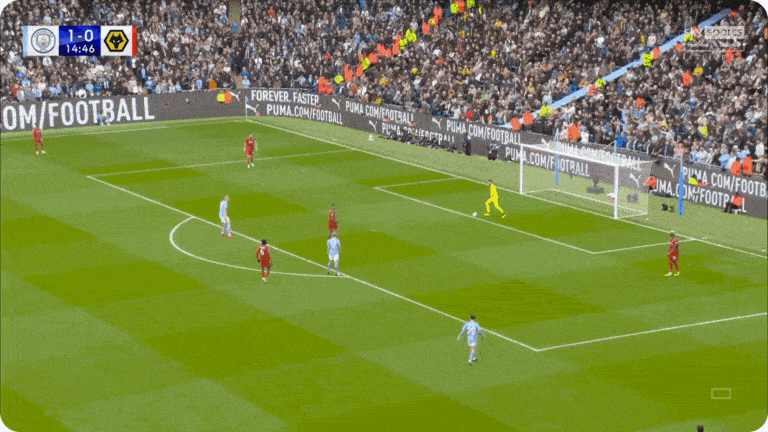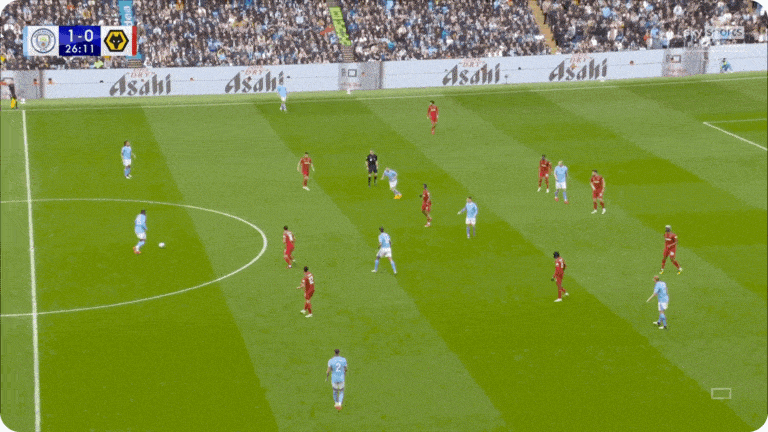- Fussball Coaches Newsletter
- Posts
- Learning Lessons - Manchester City
Learning Lessons - Manchester City
What we can learn from the City vs Wolverhampton game
Presented by
Hello and warm welcome to the latest edition of our newsletter! In this issue, the following topics take center stage:
⚽Learning Lessons - Manchester City
👉4 New Exercises!
⚽Learning Lessons - Manchester City
Following Arsenal's win against Bournemouth, Manchester City continued their dominant form by defeating Wolverhampton 5-1. Let's delve into three key factors that contributed to Manchester City's strength in the match against Wolves.
High Pressing:
The intensity of pressing naturally depends on the opponent's style of play. Wolverhampton aims for a flat build-up from the back. Therefore, aggressive pressing is particularly effective, especially after a goalkeeper's kick-off. This pressing can be practiced well in training as it always starts with a stationary ball. Manchester City was extremely successful against Wolverhampton, managing to regain possession in the opponent's half six times in the first half alone. Here, we'd like to examine three scenes from this match in more detail.
Scene 1:

The action then led to a long pass, which resulted in a loss of possession
Here is a clear illustration of how aggressively City presses with 6 or 7 players (since Gvardiol is not visible in the picture). As a result, they defend in the last line with a courageous man-to-man approach. De Bruyne advances as a midfielder and attacks together with Haaland - depending on which side the pass is played - on the central defender, while Haaland marks the defensive midfielder. Phil Foden's positioning is also crucial. He does not stay directly with the full-back Semedo but initially closes the central space to prevent the pass into the middle and intentionally provoke the pass out wide. Once the pass is played, he energetically attacks Semedo. On the other side, it's nice to see Bernardo making a curved run to block the back pass to the goalkeeper. Rodri doesn't have a direct opponent but shifts towards the ball and acts as a "sweeper". He reads the game very well and supports where he is needed near the ball.
Scene 2:

In this scene, the same processes can be observed. This time, Haaland simply attacks the center-back, while De Bruyne marks the number 5 defensive midfielder, Lemina. Bernardo Silva again makes a curved run, but then shifts his position towards the center to cover the number 6 after the ball was passed forward, eliminating the option for a back pass. City is positioned very well and tightly marked on the players, and Rodri once again acts as a "sweeper", observing the situation and providing assistance either forward or backward at the right moment
Scene 3:

From this perspective, the two scenes described earlier are clearly visible. Wolverhampton employed a different variation of the goal kick here, with the goalkeeper playing the center-back in the center of the penalty area. Nonetheless, the processes from City's point of view remain consistent. In the back line of City, they defend with a numerical advantage (unfortunately, the Wolverhampton winger is not visible in the picture on the far left), with Walker ready to press the Wolves full-back if the pass had been played to the other side. In this scenario, a strict man-marking situation would ensue.
As the pass is played to the right, the defensive line also shifts to the right to prevent the ball from easily being switched to the other side through targeted pressing. Consequently, they are positioned at the back with Walker, Akanji, Aké, and Gvardiol in numerical superiority against Wolverhampton's three attackers. Haaland and De Bruyne position themselves between the center-backs and the defensive midfielder. De Bruyne's movement already directs the pass to the other side, where Haaland then attacks the center-back. When the pass is made, De Bruyne continues his run, cutting off the option for a back pass. Thanks to Haaland's cover shadow, the passing lane to the number 6 is also blocked. This leaves only the option to pass out wide, where Foden is already waiting for. Silva then shifts closer to the center to apply more pressure, and Rodri, as always, acts as the spare man in defense.
Transition after losing possession:
In recent years, increasing emphasis has been placed on transition play. The best teams are distinguished by their ability to quickly regain possession of the ball. Good positional play is crucial for this, as nowadays coaches anticipate ball loss. Players must also mentally switch gears rapidly and react as a team, as the first few seconds are crucial for successful counter-pressing. Pep's team excels in this aspect as well. Due to their dominance in possession, Wolverhampton defended with all players behind the ball. We have prepared two scenes that demonstrate how well City sets up after losing the ball and how quickly they can transition.
Scene 1:

De Bruyne loses the ball here, and City is already very well positioned with Akanji, Aké, and Gvardiol standing closely together, along with Rodri and Kovacic positioned near and behind the ball. Walker also immediately transitions and slots into the defensive line at the back. Because of their strong positional play in possession (3-2-5 / 3-2-2-3), City was able to quickly apply pressure and regain the ball.
Scene 2:

In the second scene as well, it's evident how well City is positioned. Following a misplaced pass by Foden, De Bruyne, Kovacic, Rodri, and Walker only had to cover a short distance to immediately pressurize the player in possession and block all passing lanes. This forced only a back pass as an option, allowing City to swiftly regain possession very close to the opponent's goal. Guardiola emphasizes the importance of occupying crucial spaces. Despite his reputation for attacking football, he places extreme importance on defensive security.
Possession-based play:
Many talk about Tiki-Taka when observing Guardiola's football. But what really lies behind these short passing sequences? Guardiola has emphasized multiple times that he dislikes the term Tiki-Taka because it is simply associated with many passes without mentioning the actual objective. Every pass should have a purpose. We know that the defending team cannot simply shift quietly for 90 minutes. We all play football because we want to have the ball. Eventually, there comes a time when a player leaves their position to press the player with the ball. These are exactly the moments that should be provoked through passing. A great example of this from the game:

First, we see Phil Foden moving into space but being covered by Lemina. However, when Kovacic runs towards Akanji to offer himself, Lemina tries to press Kovacic and leaves his position. Kovacic then plays the ball back to Akanji, who immediately recognizes the situation and plays a precise pass into the space where Foden has moved into after Lemina vacated it. Foden can then open up and advance towards the goal. Therefore, it's not just about ball possession here. The intention is to deliberately provoke the opponents to leave their defensive positions.
Presented by PIX4Team
Film and stream your games without a cameraman
New: From now on, you have two payment options available. If you prefer to pay monthly, this is now possible and still represents the best offer on the market.
Here's what you get from PIX4Team:
Choose your preferred filming option:
Film with a renowned camera brand of your choice with a real optical zoom
Film with your smartphone breathtaking video quality.
Open system compatible with all sport-analyzing softwares, live streaming platforms and social media
Free PIX4TEAM REMOTE app (manage recording of the top camera and live streaming)
No subscription required (optional)
2-year warranty
Happy or money back
Dive deep into game analysis and share insights with your chosen teammates, friends or family to take your gameplay to the next level. Customize your package to perfectly suit your team or club. Craft the experience that works best for you!
🆕Use the newsletter - promo code "PIX4TEAM-5" to receive a 5% discount on your order.
👉4 New Exercises
4 new exercises are out. Get unlimited access to all existing and upcoming videos with our monthly or yearly subscription.
Exercises:
If you need more ideas for organizing your training sessions, be sure to check out the FC St. Pauli Young Rebels' Instagram page. Every Tuesday, they introduce new exercises that you can incorporate into your own team training. Additionally, we'll soon be releasing an exciting interview with Benny Hoose, the U19 coach of FC St. Pauli. Thank you so much, FC St. Pauli!
⚽If you enjoyed this post, we would appreciate your support by sharing it with other football enthusiasts who might also find it interesting.👍
Check out our Homepage for exclusive training videos and products.
Was this post forwarded to you? Subscribe here.
Have an idea or feedback to share? [email protected]




Reply